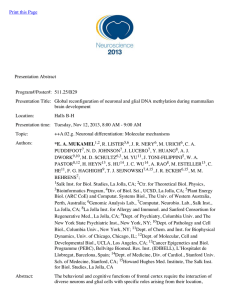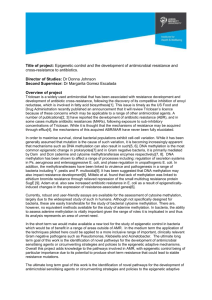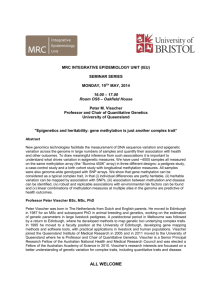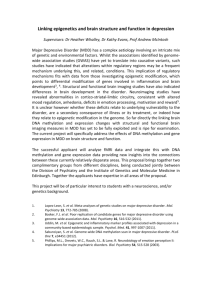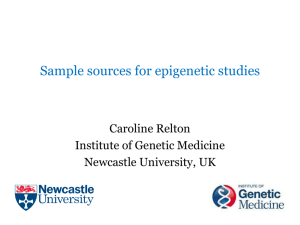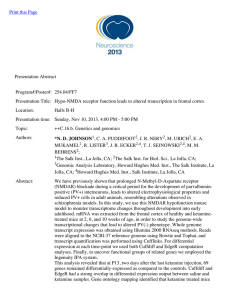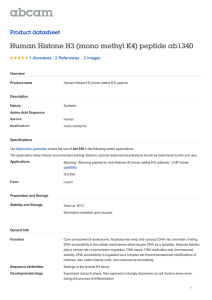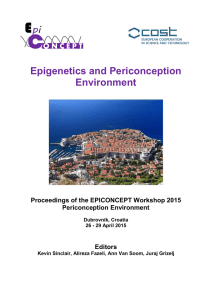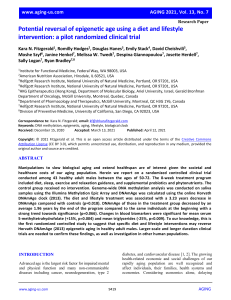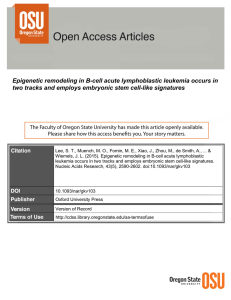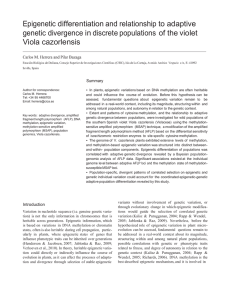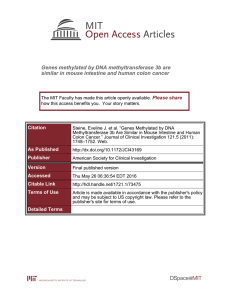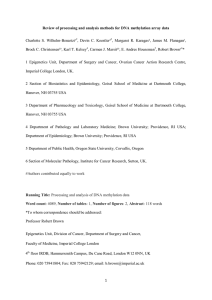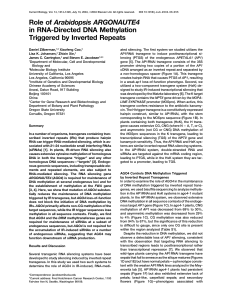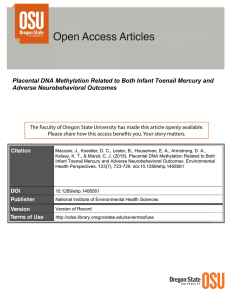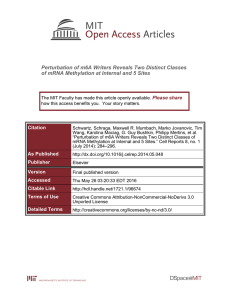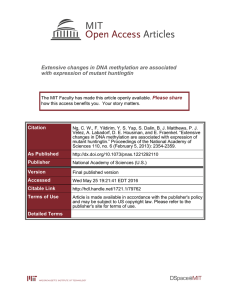Print this Page Presentation Abstract Program#/Poster#: 588.11/A11
advertisement
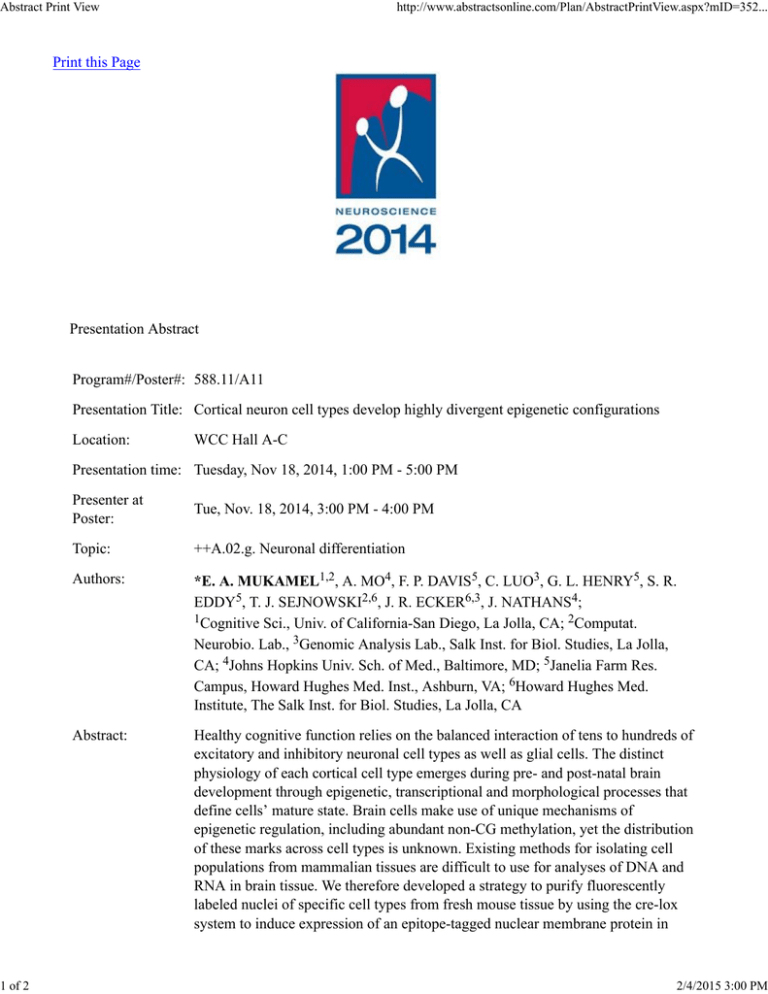
Abstract Print View 1 of 2 http://www.abstractsonline.com/Plan/AbstractPrintView.aspx?mID=352... Print this Page Presentation Abstract Program#/Poster#: 588.11/A11 Presentation Title: Cortical neuron cell types develop highly divergent epigenetic configurations Location: WCC Hall A-C Presentation time: Tuesday, Nov 18, 2014, 1:00 PM - 5:00 PM Presenter at Poster: Tue, Nov. 18, 2014, 3:00 PM - 4:00 PM Topic: ++A.02.g. Neuronal differentiation Authors: *E. A. MUKAMEL1,2, A. MO4, F. P. DAVIS5, C. LUO3, G. L. HENRY5, S. R. EDDY5, T. J. SEJNOWSKI2,6, J. R. ECKER6,3, J. NATHANS4; 1Cognitive Sci., Univ. of California-San Diego, La Jolla, CA; 2Computat. Neurobio. Lab., 3Genomic Analysis Lab., Salk Inst. for Biol. Studies, La Jolla, CA; 4Johns Hopkins Univ. Sch. of Med., Baltimore, MD; 5Janelia Farm Res. Campus, Howard Hughes Med. Inst., Ashburn, VA; 6Howard Hughes Med. Institute, The Salk Inst. for Biol. Studies, La Jolla, CA Abstract: Healthy cognitive function relies on the balanced interaction of tens to hundreds of excitatory and inhibitory neuronal cell types as well as glial cells. The distinct physiology of each cortical cell type emerges during pre- and post-natal brain development through epigenetic, transcriptional and morphological processes that define cells’ mature state. Brain cells make use of unique mechanisms of epigenetic regulation, including abundant non-CG methylation, yet the distribution of these marks across cell types is unknown. Existing methods for isolating cell populations from mammalian tissues are difficult to use for analyses of DNA and RNA in brain tissue. We therefore developed a strategy to purify fluorescently labeled nuclei of specific cell types from fresh mouse tissue by using the cre-lox system to induce expression of an epitope-tagged nuclear membrane protein in 2/4/2015 3:00 PM Abstract Print View 2 of 2 http://www.abstractsonline.com/Plan/AbstractPrintView.aspx?mID=352... defined cell types. Our purification procedure isolates both rare and abundant target cells with high yield and purity. We used this system to purify neocortical pyramidal neurons, parvalbumin (PV)-expressing fast-spiking interneurons, and vasoactive intestinal peptide (VIP)-expressing interneurons, followed by transcriptome and whole-genome methylome profiling (RNA-Seq and MethylC-seq). Genome-wide, base-resolution DNA methylation profiles reveal global and local cell specific patterns of methylation in both the CG and non-CG contexts. We identify thousands of differentially methylated regions (DMRs) across the three cell types, and integrate these data with published methylomes from fetal and developing brain as well as astrocytes. Regions that lose CG methylation during development of a specific neuron type (CG-DMRs) are enriched in active histone marks and cell type-specific transcription factor motifs. We also identify cell type-specific patterns of non-CG methylation that co-vary with gene transcription across cortical neuron types. Overall, our analysis of cell type-specific gene expression and DNA methylation gives insight into the genes and regulatory elements that may play a role in the maturation and maintenance of distinct neuronal identities. Disclosures: E.A. Mukamel: None. A. Mo: None. F.P. Davis: None. C. Luo: None. G.L. Henry: None. S.R. Eddy: None. T.J. Sejnowski: None. J.R. Ecker: None. J. Nathans: None. Keyword (s): EPIGENETICS DIFFERENTIATION INTERNEURON Support: Howard Hughes Medical Institute National Eye Institute, NIH NIH/NINDS Grant K99NS080911 2/4/2015 3:00 PM
